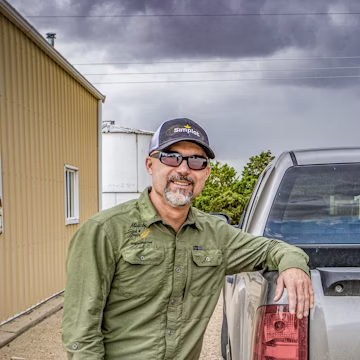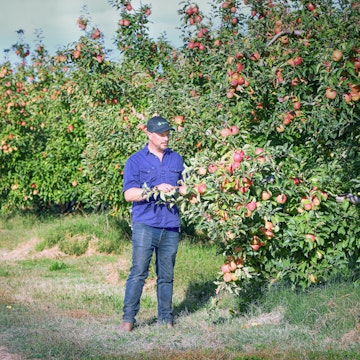
From field records to collaborating with the bank
Midcap farms was using an incumbent solution to keep track of their in-field costs, but the process was very cumbersome and made it difficult to achieve the required accuracy.
View Case StudySundquist Fruit
Sundquist Fruit is a mid-sized orchard operation in the Pacific Northwest with around 1,900 acres of fruit trees producing apples (60%), pears (30%) and cherries (10%). 4th generation family member Andrew Sundquist took over management of the organization in 2010 and has been running the business ever since together with a (non-family member) partner. With 200-250 people employed year-round and another 200 seasonal employees, structure, organization and data management are key for Sundquist Fruit says Andrew: “It’s mission-critical to our business to have accurate chemical application records, and being able to organize that on the same platforms as to-do jobs and other information makes it so much easier for myself and our staff than having to bounce around different software packages.”
Becoming a farmer wasn’t Andrew’s initial plan but, after obtaining his degree in management information systems at Washington State University and working in IT for a couple of years, he decided to move back and join the family business. It’s little surprise that one of the first things Andrew did at Sundquist Fruit was moving from a paper-based system to a digital solution he says: “ My dad had written down all of the spray jobs and work orders on a slip of paper, which was handed to a ranch manager, which was completed and then they may or may not have written everything down like they were supposed to and rubber banded them all together and stuck them in a pile on the back of the shop wall. We didn't really have a good follow through loop to make sure that everything was happening the way it needed to happen.”
“One of our first initiatives was trying to get this process dialled in and I wrote an (Microsoft) Access database for that - so we basically ‘built our own solution’. But I noticed as time went on that we needed a managed solution. Trying to manage a database on our own was just getting challenging and then trying to do everything else that you need to do on the farm on top of adding features was tough. We then tried a couple of other solutions out and used them for a few years, but I was always on the lookout for something that was better than what we were currently using. We went through a few different programs and then I found Agworld in 2014, which we have been using ever since.”
Andrew continues: “Having built our own solution previously gives me some insight and experience into this process, and it didn’t work for us even though I have a degree and experience in that exact field, so it’s not something I would recommend to anyone. The solutions that you build on your own may be a little more flexible but they require a lot more attention. They tend to be a little more nuanced than some of the third party solutions. That's what I've found, it's like when you build it yourself it makes sense to you, but trying to get everybody else on board is a challenge. You become not only the farmer, you're the developer, you're the support team. Creating your own solution can become overwhelming pretty quickly and you may end up, in the long run, with more limitations than if you partner with a provider that is really good at systems development.”
Sundquist Fruit uses Agworld to create their seasonal plans, as well as log all activities deployed in the orchard throughout the year. Andrew explains that this has been a gradual process: “We started to use the planning side of Agworld more after an update was made to the platform last year that allows us to consolidate plans when we convert them. With the way we run our orchard operations, having to convert blocks one at a time wasn’t feasible for me, but the upgrades that Agworld have made to the planning side of things last year have made a big difference to us.”
Andrew continues: “We’re also trying to log an increasing amount of job types into Agworld. We initially started with just the foliar applications and other liquid sprays, and then a few years ago we started to enter all of our dry and liquid fertilizers as well. As of last year we’re trying to enter as much as we can by adding all of our activities, regardless of job type, into Agworld. So this includes pruning, thinning and other jobs - which forms a good ‘to-do list’ for us as it shows us what we still need to do in an easily-digestible format.”
It’s not just Andrew using Agworld within the orchard operation, but other key staff as well he explains: “Our farm managers have access to Agworld and can enter jobs or mark them completed. In some cases we have assistants that organize the tractor drivers and applicators so they can enter application records directly into Agworld. Our office staff have access too although they do not use Agworld on a daily basis yet - but it’s very helpful for them to have access to Agworld and being able to see the exact same data, maps etc. as I’m seeing without having to worry about anything not being updated."
Andrew adds that keeping a central repository of data up-to-date is very much a team effort, which requires buy-in of the whole team. “I think that our team is really good about entering data into Agworld and using it like they are supposed to. Most enter the data as soon as a job has been performed while others might do it at the end of the day; everybody has been directed to enter their actuals on the same day as they are done, which I think is crucial to keeping the data accurate. In the end, that’s what makes Agworld such a good fit with our organization: our people like using it and because of that we get high-quality data entered onto the platform. Having this data at my disposal at all times then helps me in many aspects of my job.”
"When you build it yourself it makes sense to you, but trying to get everybody else on board is a challenge. You become not only the farmer, you're the developer, you're the support team"Andrew Sundquist Sundquist Fruit, Yakima, WA

Midcap farms was using an incumbent solution to keep track of their in-field costs, but the process was very cumbersome and made it difficult to achieve the required accuracy.
View Case StudyOrchard margins in Australia have been slowly decreasing over the past 40 years, leading to orchards becoming increasingly more volume driven. With no digitised record keeping system in place, the McNab family did not have a clear understanding of their cost of production and margin by variety.
View Case Study





